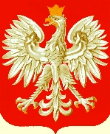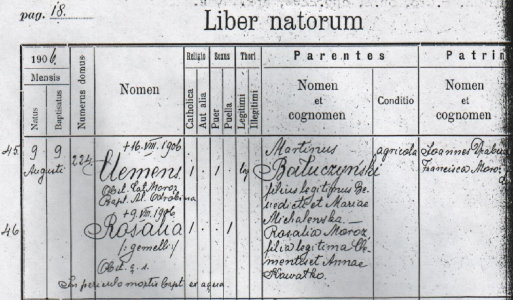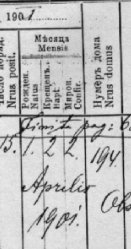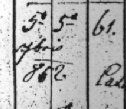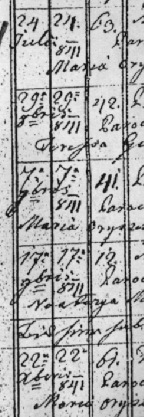Baptismal/Birth Record, Part 1Click on any part of the record below for a description and to go to that explanation. Or you can scroll down the page on your own.
The parish priest kept a record of all baptisms and births in the parish. Before 1784 the records for all the villages in the parish were kept together. However, after 1784, records for each particular village were kept separately. They may have been bound in the same book, but a separate listing for each village was organized alphabetically by village, year by year. When searching for ancestors, never concentrate solely on one village, or even one parish for that matter. Although itís commonly thought that people never moved great distances outside their birth village, you will find people often marrying into families in neighboring villages and/or parishes. Explanation of each column 1. Numerus Serialis or Nr. posit. (Serial Number or Position Number)
Often the first column to the left is found the Serial or Position Number. The priest numbered each record of baptism/birth sequentially: (1, 2, 3, etc.). Each year the priest started over with number one. This was done to show that no oneís name could have been added or removed at a later date. This simple information can be used by the genealogist to help cite information for your own family history. This extra citation will ensure your proper record keeping. Of course, it is not essential. However, if you would like this extra "protection", especially if the birth record contains names in a foreign language, in particular a foreign alphabet, you may do this. Furthermore, by tracking the sequential numbering of the births, one can determine any missing pages or pages out of order (which sometimes happens when researching microfilmed copies that may have been microfilmed out of order). On some forms, this information is not found. For example, the graphic found at the very top of this page does not have the column, but still shows that the priest kept a running number order in the margin.
2. Dies et Mensis Natus et Baptisatus (Day and Month of Birth and Baptism)
You should note both of these dates and not just the birth. Many genealogists concern themselves only with the actual birth date. However, one should keep both. Sometimes you may find ripped pages or pages not properly microfilmed where youíll only find one of the dates. Make sure that you mark it correctly as either the birth or the baptism, depending on which one of the two is present. Be careful when noting the month and year. Often the month and year is not written for each and every personís listing, only the date. Carefully backtrack to the last month and year listed. Do so carefully so as to not skip a month or year and mark the wrong one down. Be careful of this especially when researching at an archive where photocopying is not available. Unlike using microfilm at a local Family History Center, you may not easily have a chance to return to the originals to verify your note-taking. The months will usually be in Latin. This should not be a problem if the month is written out as the Latin resembles the English. In older Greek Catholic records, you may find the month in Church Slavic. Again, this will be easy IF you can read the Cyrillic alphabet since the Church Slavic terms also resemble the English. For a list of months in different languages, visit my page on months. Note the confusion over the written number of the month, in the case of 7-bris, 8-bris, 9-bris, and 10-bris (or 7ber, 8ber, 9ber, 10ber). These are NOT the numbers correlated to the way we count months today! They are based on the old calendar where the first month of the year wasnít January, but March. This makes sense if you look at the Latin meaning behind these four months. Study the roots of these months:
"Sept" stands for Seven (7) in Latin. Therefore: 7-bris is September, not July
"Octo" stands for Eight (8) in Latin. Think of the word "octagon" "Novem" stands for Nine (9) in Latin. "Decem" stands for Ten (10) in Latin. Think "decade" or "decagram" Therefore: 8-bris is October, not August 9-bris is November, not September 10-bris is December, not October
Poland adopted the Gregorian Calendar (the one we use today) in 1582. The Greek Catholic church records were kept in the Gregorian Calendar. This is different than record keeping in neighboring Russian Empire, which kept the Julian Calendar until 1918. Depending on the year, there is about a two week difference between the two calendars. After the tsarís government ended, the newly formed USSR adopted the Gregorian Calendar. So, the day after January 31, 1918 was February 13, 1918. (In the mid 1800ís, the difference was usually 12 days.) As a side note, some branches of the Orthodox church today still officially use the Julian Calendar. As you can see, this makes for easier research in Halychyna/Eastern Galicia than it does for our genealogical colleagues researching ancestors in the Russian Empire.
3. Numerus Domus (House Number)Click here to see a detailed description, important usage, and often misunderstood column House Number.
|
|
www.halgal.com
Questions and Comments to Matthew
Bielawa |
